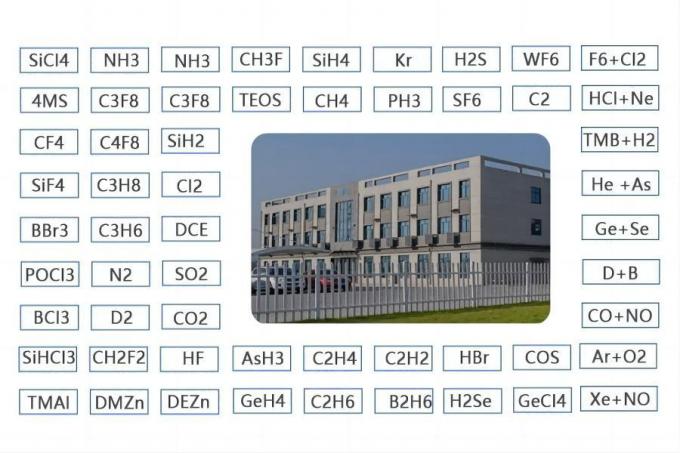


| MOQ: | 1 Piece |
| Price: | US $300/PC |
| Standard Packaging: | Cylinder/Tank |
| Delivery Period: | 15 days |
| Payment Method: | L/C, T/T |
| Supply Capacity: | 3000 Pcs/Month |
Helium gas is a colorless, odorless, and tasteless element that is the second lightest and second most abundant element in the universe, after hydrogen. It is a non-toxic, inert gas that exists as a monatomic molecule, denoted as He, and is chemically stable.
Helium is extracted from natural gas deposits through a process called fractional distillation. It is often found in small amounts within natural gas reservoirs, where it is produced as a result of the decay of radioactive elements such as uranium and thorium. Helium is typically isolated by cooling the natural gas to extremely low temperatures, causing other gases to liquefy and separate, leaving behind helium gas.
One of the most well-known properties of helium is its low boiling point, which is just a few degrees above absolute zero (-268.93 degrees Celsius or -452 degrees Fahrenheit). This property allows helium to be used as a cooling agent in various applications, such as cryogenics and superconductivity research.
Helium has several important uses due to its unique properties. The most common application of helium is in filling balloons and airships, where its low density provides buoyancy. It is also used in various industrial processes, such as cooling and purging systems, as a shielding gas in arc welding, and as a component in gas mixtures for deep-sea diving.
In addition to its practical applications, helium is also used in scientific research, particularly in fields such as nuclear physics, spectroscopy, and as a carrier gas in gas chromatography. Helium has the lowest boiling point of all the elements, and when cooled to extremely low temperatures, it exhibits extraordinary properties, including superfluidity and superconductivity.
However, it is worth noting that helium is a finite resource on Earth, and its availability is limited. Once released into the atmosphere, helium gas escapes into space due to its lightness, making it difficult to recycle and replenish. As a result, there have been concerns about helium shortages and the need for conservation and responsible use of this valuable resource.
Basic Info.
| DOT Class | 2.2 | Un Number | 1963 |
| Cylinder Standard | DOT/ISO/GB | Cylinder Pressure | 15MPa/20MPa |
| Valve | Qf-2/Cga580 | Melting Point | -272.2 ºC |
| Appearance | Colorless, Odorless | Boiling Point | -272.2 ºC |
| Density | 0.1786 Kg/M3 | Molecular Weight | 4.0026 |
| Transport Package | 40L, 47L, 50L | Specification | 99.999%, 99.9999% |
| Trademark | CMC | Origin | Suzhou,China |
| HS Code | 28042900 | Production Capacity | 20, 000 Tons/Yea |
![]()
![]()
| Specification | Company Standard |
| He | ≥ 99.999% |
| N2 | ≤ 2.0 ppm |
| O2+AR | ≤ 1.0 ppm |
| H2 | ≤ 1.0 ppm |
| CO | ≤ 0.5 ppm |
| CO2 | ≤ 0.5 ppm |
| Ne | ≤ 1.0 ppm |
| CH4 | ≤ 0.5 ppm |
| Moisture | ≤ 0.5 ppm |




| MOQ: | 1 Piece |
| Price: | US $300/PC |
| Standard Packaging: | Cylinder/Tank |
| Delivery Period: | 15 days |
| Payment Method: | L/C, T/T |
| Supply Capacity: | 3000 Pcs/Month |
Helium gas is a colorless, odorless, and tasteless element that is the second lightest and second most abundant element in the universe, after hydrogen. It is a non-toxic, inert gas that exists as a monatomic molecule, denoted as He, and is chemically stable.
Helium is extracted from natural gas deposits through a process called fractional distillation. It is often found in small amounts within natural gas reservoirs, where it is produced as a result of the decay of radioactive elements such as uranium and thorium. Helium is typically isolated by cooling the natural gas to extremely low temperatures, causing other gases to liquefy and separate, leaving behind helium gas.
One of the most well-known properties of helium is its low boiling point, which is just a few degrees above absolute zero (-268.93 degrees Celsius or -452 degrees Fahrenheit). This property allows helium to be used as a cooling agent in various applications, such as cryogenics and superconductivity research.
Helium has several important uses due to its unique properties. The most common application of helium is in filling balloons and airships, where its low density provides buoyancy. It is also used in various industrial processes, such as cooling and purging systems, as a shielding gas in arc welding, and as a component in gas mixtures for deep-sea diving.
In addition to its practical applications, helium is also used in scientific research, particularly in fields such as nuclear physics, spectroscopy, and as a carrier gas in gas chromatography. Helium has the lowest boiling point of all the elements, and when cooled to extremely low temperatures, it exhibits extraordinary properties, including superfluidity and superconductivity.
However, it is worth noting that helium is a finite resource on Earth, and its availability is limited. Once released into the atmosphere, helium gas escapes into space due to its lightness, making it difficult to recycle and replenish. As a result, there have been concerns about helium shortages and the need for conservation and responsible use of this valuable resource.
Basic Info.
| DOT Class | 2.2 | Un Number | 1963 |
| Cylinder Standard | DOT/ISO/GB | Cylinder Pressure | 15MPa/20MPa |
| Valve | Qf-2/Cga580 | Melting Point | -272.2 ºC |
| Appearance | Colorless, Odorless | Boiling Point | -272.2 ºC |
| Density | 0.1786 Kg/M3 | Molecular Weight | 4.0026 |
| Transport Package | 40L, 47L, 50L | Specification | 99.999%, 99.9999% |
| Trademark | CMC | Origin | Suzhou,China |
| HS Code | 28042900 | Production Capacity | 20, 000 Tons/Yea |
![]()
![]()
| Specification | Company Standard |
| He | ≥ 99.999% |
| N2 | ≤ 2.0 ppm |
| O2+AR | ≤ 1.0 ppm |
| H2 | ≤ 1.0 ppm |
| CO | ≤ 0.5 ppm |
| CO2 | ≤ 0.5 ppm |
| Ne | ≤ 1.0 ppm |
| CH4 | ≤ 0.5 ppm |
| Moisture | ≤ 0.5 ppm |


